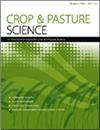转录组分析显示了大豆(Glycine max)对菌核病(sclerotinia stem rot, SSR)的抗性和易感性差异表达基因(DEGs)的代谢途径和候选基因挖掘
IF 1.8
4区 农林科学
Q2 AGRICULTURE, MULTIDISCIPLINARY
引用次数: 0
摘要
菌核病是严重影响大豆产量的病害之一,在世界范围内造成重大损失。一个著名的抗SSR品种是“枫箭”。目的通过对抗性品种“枫箭”和敏感品种“禾丰25”的转录组测序分析,了解大豆品种对SSR的抗性机制,寻找候选基因。方法对Maple Arrow和Hefeng25进行RNA测序,分别获得75.09GB和64.97GB的干净读数。在不同的可比较组中共发现417个差异表达基因(DEGs)。对“枫箭”和“和风25”不同表达水平的基因进行了基因本体富集、京都基因与基因组百科全书分析和单倍型分析。结果发现,枫箭和和风25的DEGs参与了“氧化还原过程”、“转录调节”、“氨基酸代谢”、“甲基化”和“膜”、“膜的组成部分”以及“表皮生长因子受体底物15”的调控。共筛选出12个基因的31个单倍型,在不同SSR抗性水平的大豆中存在显著或极显著差异。结论这些基因可能参与大豆硬化糖的相关通路。意义为进一步抗病育种提供优良的基因资源。本文章由计算机程序翻译,如有差异,请以英文原文为准。
Transcriptome analysis showed the metabolic pathway of differentially expressed genes (DEGs) in resistant and susceptible soybean (Glycine max) to sclerotinia stem rot (SSR) and candidate gene mining
Context Sclerotinia stem rot (SSR) is one of the diseases that seriously affect soybean yield, leading to heavy losses all over the world. A well-known SSR resistant variety is ‘Maple Arrow’.Aims In this study, transcriptome sequencing analysis of resistant variety ‘Maple Arrow’ and susceptible variety ‘Hefeng25’ was conducted to understand the resistance mechanism of resistant and susceptible soybean varieties to SSR and to look for candidate genes.Methods RNA sequencing of Maple Arrow and Hefeng25 generated 75.09GB and 64.97GB clean readings, respectively. In total, 417 differentially expressed genes (DEGs) were found among the different comparable groups. Gene ontology enrichment, Kyoto Encyclopedia of Genes and Genomes analysis and haplotype analysis were performed for genes with different expression levels in Maple Arrow and Hefeng25.Key results It was found that DEGs from Maple Arrow and Hefeng25 were involved in the regulation of ‘oxidation–reduction process’, ‘regulation of transcription’, ‘amino acid metabolism’, ‘methylation’ and ‘membrane’, ‘integral component of membrane’ and ‘epidermal growth-factor receptor substrate 15’. In total, 31 haplotypes of 12 genes were screened out with significant or extremely significant differences among soybeans with different levels of SSR resistance.Conclusions These genes may be involved in the relevant pathways of soybean sclerotiniose.Implications To provide excellent gene resources for further disease-resistance breeding.
求助全文
通过发布文献求助,成功后即可免费获取论文全文。
去求助
来源期刊

Crop & Pasture Science
AGRICULTURE, MULTIDISCIPLINARY-
CiteScore
4.20
自引率
15.80%
发文量
111
审稿时长
3 months
期刊介绍:
Crop and Pasture Science (formerly known as Australian Journal of Agricultural Research) is an international journal publishing outcomes of strategic research in crop and pasture sciences and the sustainability of farming systems. The primary focus is broad-scale cereals, grain legumes, oilseeds and pastures. Articles are encouraged that advance understanding in plant-based agricultural systems through the use of well-defined and original aims designed to test a hypothesis, innovative and rigorous experimental design, and strong interpretation. The journal embraces experimental approaches from molecular level to whole systems, and the research must present novel findings and progress the science of agriculture.
Crop and Pasture Science is read by agricultural scientists and plant biologists, industry, administrators, policy-makers, and others with an interest in the challenges and opportunities facing world agricultural production.
Crop and Pasture Science is published with the endorsement of the Commonwealth Scientific and Industrial Research Organisation (CSIRO) and the Australian Academy of Science.
 求助内容:
求助内容: 应助结果提醒方式:
应助结果提醒方式:


